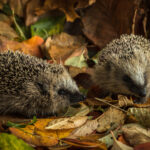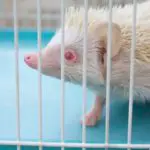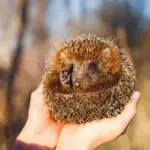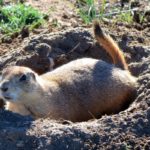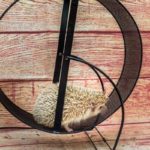Most people who are interested in keeping or researching hedgehogs will be familiar with the commonly domesticated hedgehog species, such as the Four-Toed Hedgehog, European Hedgehog, or African Pygmy Hedgehog.
However, there are plenty of other fascinating hedgehog species out there in the wild to learn about. One such hedgehog species is the Northern White-Breasted Hedgehog, which can be found across most of Europe, from Austria to Russia.
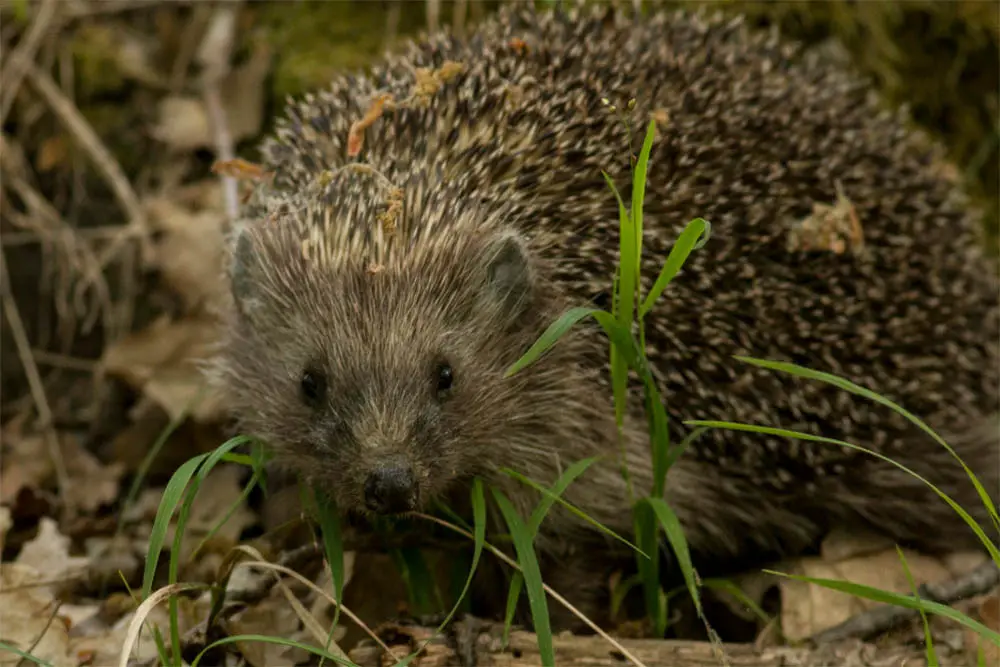
While the Northern White-Breasted Hedgehog is not often kept as a pet, it lives in close proximity with humans and man-made structures for its own benefit. Given its willingness to interact with humans in this way, the Northern White-Breasted Hedgehog is one of the most important species for hedgehog enthusiasts to learn about.
Read on for all the information you could need regarding the Northern White-Breasted Hedgehog, including taxonomy, distribution, behaviors, health, and dietary requirements.
Taxonomy
The first step to understanding any animal is to look at where the species stands in terms of its relation to other families and species in the animal kingdom.
Interestingly enough, the taxonomy of the Northern White-Breasted Hedgehog is quite complicated due to the fact that it has changed over time.
Initially, scientists had classified the Northern White-Breasted Hedgehog as a subspecies of the established European Hedgehog, known scientifically as Erinaceus europaeus.
After a time, the classification was amended, and the Northern White-Breasted Hedgehog was proclaimed to be a subspecies of a different hedgehog species: the Southern White-Breasted Hedgehog, or Erinaceus concolor.
It wasn’t until the 1990s that the Northern White-Breasted Hedgehog was classified as its own species.
It is now known as Erinaceus roumanicus. Today, the species is actually considered to have five subspecies, which are as follows: Erinaceus roumanicus roumanicus, Erinaceus roumanicus drozdovskii, Erinaceus roumanicus nesiotes, Erinaceus roumanicus pallidus, and Erinaceus roumanicus bolkayi.
The Erinaceus genus is comprised of four species, although many subspecies are also included.
The Northern White-Breasted Hedgehog is part of the family Erinaceidae, where it is accompanied by other hedgehog species as well as small mammals called moonrats.
Its order is Eulipotyphla, and it is classified under the Mammalia class, which, of course, simply indicates its status as a mammal.
Identifying Features
If you ever encounter a Northern White-Breasted Hedgehog in the wild, you’ll be able to identify it by some of its key physical features.
The first thing you’re likely to notice when coming across a Northern White-Breasted Hedgehog is the fact that its throat and abdomen are significantly lighter than its back and sides.

The chest area contrasts strikingly with the rest of the hedgehog’s body because it is white, which is where the Northern White-Breasted Hedgehog derives its common name.
The Northern White-Breasted Hedgehog is a fairly average-sized hedgehog, measuring up to 35 cm when fully grown. It can weigh up to 1 kg.
Geographical Distribution
We’ve briefly touched on the distribution of the Northern White-Breasted Hedgehog across Europe, but to reiterate, the Northern White-Breasted Hedgehog can be found in most of Europe.
The area of Europe in which Northern White-Breasted Hedgehog populations can be found ranges from Austria (the furthest point West) to Russia (the furthest point East).
The Southernmost point of the Northern White-Breasted Hedgehog’s distribution is Greece.
If you link these points on a map, you’ll be able to see that Northern White-Breasted Hedgehog populations cover the majority of Eastern Europe and extend West up until France.
Conservation Status
Most hedgehog species are not considered to be threatened or endangered in terms of their conservation status, and the Northern White-Breasted Hedgehog is no exception.
The conservation status of the Northern White-Breasted Hedgehog is listed as ‘Least Concern,’ which is the best-case scenario for the conservation and continuation of a species.
For context, the spectrum of conservation status, as defined by the IUCN (International Union for Conservation of Nature), ranges from ‘Least Concern’ to ‘Extinct.’
Rankings between the two extremes, from most to least severe, include ‘Extinct in the Wild’ (as opposed to in captivity), ‘Critically Endangered,’ ‘Endangered’, ‘Vulnerable,’ ‘Near Threatened,’ and ‘Conservation Dependent.’
What this data tells us is that the Northern White-Breasted Hedgehog is not an endangered or even a vulnerable species, indicating that the species is still thriving and repopulating itself in the wild without conservation intervention.
Behavioral Traits
The Northern White-Breasted Hedgehog is a synanthrope, which means that it actually benefits from its proximity and interaction with humans and human constructions.
Therefore, it’s not uncommon for this hedgehog species to actively seek out environments constructed or populated by humans.
The Northern White-Breasted Hedgehog may appear to be less intimidated by humans in comparison to other hedgehog species that aren’t usually domesticated.
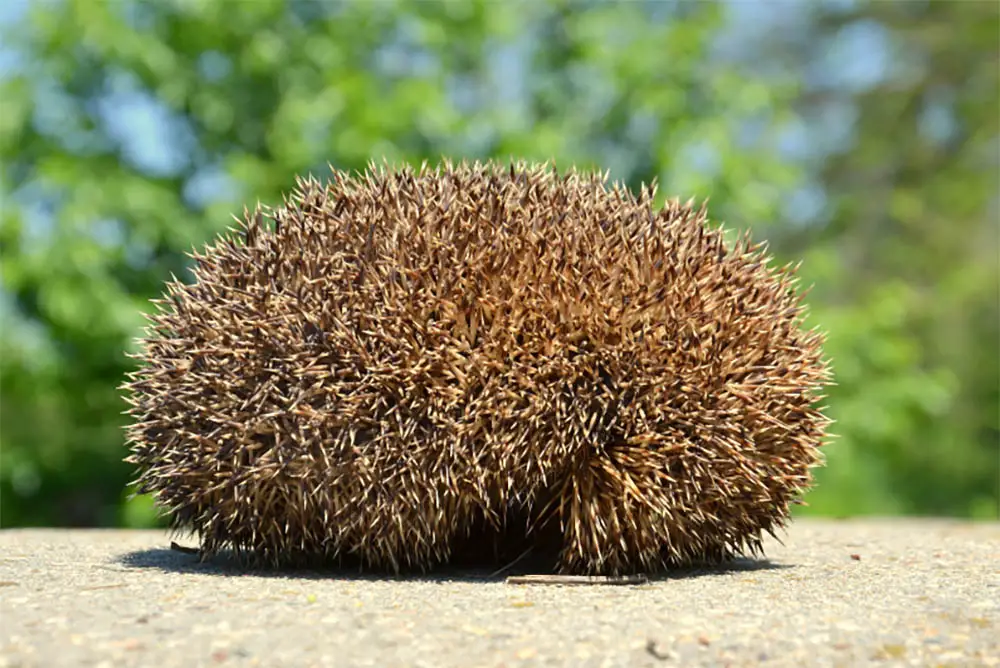
With that being said, as with all hedgehogs under the umbrella of the Erinaceus genus, the Northern White-Breasted Hedgehog is nocturnal, so it’s active at night as opposed to during the day. Therefore, its direct interactions with humans in the wild are relatively limited.
If you notice a Nothern White-Breasted Hedgehog covering its own spines with saliva, don’t be alarmed.
While this ritual certainly looks very strange (and is made stranger by the fact that scientists still aren’t sure why exactly Erinaceus hedgehogs do it), it’s a typical behavior and not out of the ordinary.
Outside of the breeding season, you’ll usually find Northern White-Breasted Hedgehogs on their own since they are normally solitary creatures until it comes time to mate.
Diet
Like all members of the Erinaceus genus, the Northern White-Breasted Hedgehog is omnivorous, which means that its diet is made up of a variety of food sources.
In the past, it was thought that the Northern White-Breasted Hedgehog and its Erinaceus friends were primarily insectivorous, meaning an animal that eats a diet made up entirely of insects.
While it’s true that the Northern White-Breasted Hedgehog is perfectly happy to tuck into invertebrates and even vertebrates (as long as they are small enough) when they are available, it also gets its nutrients from plant matter, vegetables, and fruit.
The scope of the Northern White-Breasted Hedgehog’s diet proves it to be just as mighty as it is small. When there is no more easily obtainable food in its vicinity, this hedgehog will go as far as to tackle potential predators such as venomous snakes!
In fact, scientific studies have revealed that Northern White-Breasted Hedgehogs have an increased resistance to snake venom for this purpose.
Health
Most of the health concerns surrounding the Northern White-Breasted Hedgehog are related to its tendency to carry certain external parasites.
These parasites can be damaging to the hedgehog itself on a dermatological level, but they can also be dangerous to other animals or human beings that the hedgehog interacts with.
One of the most common parasites carried by the Northern White-Breasted Hedgehog is Ixodes hexagonus, also known as the hedgehog tick.
The hedgehog tick, as you might be able to guess by its common name, is a species of tick that specifically preys on hedgehogs – European hedgehogs, to be precise. Although hedgehogs are the tick’s preferred host, it has also been known to infect dogs, cats, foxes, and badgers.
Ixodes hexagonus lives in hedgehog nests, which means that it typically survives for longer than your average tick due to the fact that the nest environment shields it from the elements.
As a result, the hedgehog tick is able to continue to prey on both hedgehogs and other animals (including humans) that it comes into contact with for a long time.
The Northern White-Breasted Hedgehog is also a favored host for the Ixodes ricinus tick, also known as the castor bean tick. This is the most widespread tick species in Europe.
What makes the Ixodes hexagonus tick and Ixodes ricinus tick especially dangerous is the fact that they can spread Lyme disease. Lyme disease is a condition spread to humans and other animals by certain tick species.
It’s a bacterial infection, initially characterized by a rash that circles the initial tick bite, although this symptom may not develop for up to 4 weeks.
Usually, Lyme disease manifests as flu-like symptoms, which might even disappear without treatment. However, in some cases, the infection can spread from the site of the bite to other areas of the body, which can lead to more severe symptoms such as neurological problems, heart conditions, or hepatitis.
Please note that even if symptoms disappear without intervention, treatment for Lyme disease should be sought as soon as possible to prevent the onset of further, potentially more dangerous symptoms.
Additionally, the Ixodes ricinus tick can spread tick-borne encephalitis, which can cause paralysis, neurological disease, and in some cases, death.
Legality of Ownership
In the U.S., there is no specific legislation against the ownership of a Northern White-Breasted Hedgehog in particular.
However, there are rules and regulations concerning the ownership of hedgehogs overall, and your potential ownership of a Northern White-Breasted Hedgehog will be subject to these laws.
First and foremost, it is important to note that some states in the U.S. permit the ownership of hedgehogs on a domestic level, while others strictly prohibit such ownership.

If you reside in New York, Washington D.C., Omaha, Georgia, Nebraska, Pennsylvania, Hawaii, or California, unfortunately, you won’t be able to keep any species of hedgehog as a pet, including the Northern White-Breasted Hedgehog.
Please be aware that even if your state of residence does not appear on the above list, you should still do your due diligence to find out whether a permit is required for hedgehog ownership in your area, or whether there are any restrictions in place regarding the keeping of hedgehogs.
New Jersey and Wisconsin, for example, have laws in place that require a permit or veterinary inspection certificate before ownership can be officially permitted.
As we’ve mentioned already, keeping a Northern White-Breasted Hedgehog as a pet is quite unusual because this species is not usually domesticated. Therefore, acquiring a Northern White-Breasted Hedgehog for domestication is likely to be more difficult than, say, a Four-Toed Hedgehog.
Since Northern White-Breasted Hedgehogs are native to Europe, bringing one into the United States would involve a series of steps to ensure the safety of any surrounding wildlife or human beings.
According to the CDC’s (Centers for Disease Control and Protection) legislation on the subject of European hedgehog importation (found under the section concerning small mammals and rodents that are not native to Africa), you can import a Northern White-Breasted Hedgehog into the U.S.
However, due to the Northern White-Breasted Hedgehog’s status as a tick carrier (via which Lyme disease can be spread), the hedgehog will be subject to regulation number 42CFR71.54.
This area of legislation states that where an animal is known to be a carrier or potential carrier of zoonotic disease (meaning a disease that can be transmitted between humans and other animals), a permit for the animal will need to be granted by the CDC’s director before importation. In the absence of such a permit, the animal will be held in custody by U.S. Customs.
Care Guide
Keeping a Northern White-Breasted Hedgehog as a pet is relatively uncommon since the majority of domesticated hedgehogs in the U.S. are from three species: the African Pygmy Hedgehog, the European Hedgehog, and the
However, if you come across a sick or injured Northern White-Breasted Hedgehog, you might find yourself in the position of needing to care for the hedgehog on a temporary or even permanent basis.
Hedgehogs of all varieties need spacious enclosures so that they don’t feel trapped or claustrophobic in comparison to their usual habitat.
While experts typically set the minimum requirement at roughly 8 square feet in terms of floor space, we’d advise all potential Northern White-Breasted Hedgehog owners to surpass these measurements if possible. The larger you can make your hedgehog’s enclosure, the better.
Wire cages (particularly wire flooring) should be avoided because they present a hazard to hedgehogs’ tiny feet.
Because Northern White-Breasted Hedgehogs are omnivorous, you should try to provide yours with as much variety in terms of food as possible. The more different types of food you can offer, the healthier your Northern White-Breasted Hedgehog will become because it will be having all of its nutritional needs met.
Try to incorporate a variety of small insects, vegetables, fruit, and fungi into your hedgehog’s diet and keep a bowl of water in its enclosure so that it can stay hydrated.
Unlike some hedgehog species in Asia and Africa, which are accustomed to incredibly dry environments and have adapted to obtaining most of their water from the insects in their diets, Northern White-Breasted Hedgehogs are more reliant on direct water sources.
With all of that being said, because of the Northern White-Breasted Hedgehog’s reputation as a carrier of ticks (and, by extension, Lyme disease or tick-borne encephalitis), we strongly recommend keeping physical interaction with the hedgehog itself to an absolute minimum.
This is also the main reason why we don’t recommend keeping Northern White-Breasted Hedgehogs as pets in general.
If you must interact with a Northern White-Breasted Hedgehog for the purpose of providing care, we recommend wearing long sleeves and pants as well as protective equipment, if possible.
Even then, we would advise you to transfer the hedgehog into the care of a professional veterinarian at the earliest opportunity for the health and safety of all involved.
Frequently Asked Questions
How does the Northern White-Breasted Hedgehog differ from the Southern White-Breasted Hedgehog?
Although the Southern White-Breasted Hedgehog shares the white chest patch that helps to identify the Northern White-Breasted Hedgehog, these two hedgehog species are not as similar as scientists once thought.
As we mentioned earlier, the historical taxonomy of the Northern White-Breasted Hedgehog indicates that scientists once believed the species to be a subspecies of the Southern White-Breasted Hedgehog.
However, further observation of the two species has confirmed enough differences between the two to classify them as separate species.
The main behavioral difference between the two species is that while the Northern White-Breasted Hedgehog prefers to physically dig down into the earth to create a den, the Southern White-Breasted Hedgehog collects grass and foliage to construct a nest.
Final Thoughts
In summary, Northern White-Breasted Hedgehogs are non-domesticated hedgehogs that live across the majority of Eastern and Central Europe, encroaching onto Western Europe, between Russia and Austria.
Northern White-Breasted Hedgehogs can be easily identified by the striking white patch on its chest, which is clearly visible in contrast to its otherwise brown body.
This hedgehog is omnivorous and nocturnal. It is also synanthropic, so it relies upon the products of human activity as part of its lifestyle.
Despite its synanthropic nature, the Northern White-Breasted Hedgehog is not an ideal choice of pet because it is so prone to tick infestations. Particularly, it is used as a host by Ixodes hexagonus and Idoxes ricinus, both of which can spread disease to humans and other animals.
While there is nothing specifically written in U.S. legislation banning the Northern White-Breasted Hedgehog, except in the states that have banned hedgehog ownership as a whole, you would still need a permit from the director of the CDC if you wanted to import this hedgehog from Europe.

